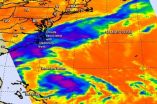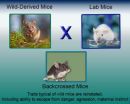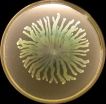(Press-News.org) Two instruments or "eyes" from NASA's Aqua satellite were peering at Hurricane Bertha in the North Atlantic Ocean shortly after it became the season's second hurricane. Bertha's hurricane status didn't last long as it weakened to a tropical storm today, August 5.
The Atmospheric Infrared Sounder or AIRS instrument aboard Aqua provides infrared data, while the Moderate Resolution Imaging Spectroradiometer or MODIS instrument provides visible data. Together, these instruments give scientists and forecasters a good look inside and outside of the storm to help determine what's happening.
At 11 a.m. EDT (1500 UTC) on August 4, reports from NOAA and air force hurricane hunter aircraft indicated that the maximum sustained winds had increased to near 80 mph (130 kph) and Bertha became a hurricane.
NASA's Aqua satellite passed over Hurricane Bertha at 1:47 p.m. EDT and the AIRS instrument gathered infrared data and cloud top temperature data on the storm, while the MODIS instrument snapped a visible image of the storm three minutes later. The MODIS image did not reveal an eye, and showed a thick band of thunderstorms wrapping into the center of circulation from the southeast.
When Aqua cast an infrared eye on the storm using the AIRS instrument, it provided information on cloud top heights and temperatures. The highest, coldest cloud top temperatures appeared around the center of circulation and in the eastern quadrant of the storm. The AIRS image also showed high clouds in a line off the U.S. East Coast from a stationary front.
On August 5 at 5 a.m. EDT (0900 UTC), Bertha had weakened back into a tropical storm. At that time Bertha's maximum sustained winds were near 65 mph (100 kph) over a small area northeast of the center.
The center of tropical storm bertha was located near latitude 33.4 north and longitude 72.9 west. That puts the center about 475 miles (765 km) west of Bermuda. Bertha was moving toward the north-northeast near 22 mph (35 kph) and the NHC expects a turn to the northeast and increase in forward speed. The minimum central pressure recently reported by a U.S. Air Force Reserve reconnaissance aircraft was 1005 millibars.
The National Hurricane Center has forecast gradual weakening over the next two days.
INFORMATION:
Text credit: Rob Gutro
NASA's Goddard Space Flight Center
NASA's Aqua satellite puts two eyes on Hurricane Bertha
2014-08-05
ELSE PRESS RELEASES FROM THIS DATE:
Training schemes help jobless men feel better about themselves
2014-08-05
Do the UK government's welfare-to-work training schemes improve the happiness and well-being of its unemployed citizens? Yes, and especially that of jobless men, says Daniel Sage of the University of Stirling in the UK in an article in Springer's Journal of Happiness Studies. His detailed analysis of data from the UK's Annual Population Survey shows that such active labor market programs that mimic the routines of the workplace work best.
Being unemployed can have a long-term scarring effect on a person's subjective sense of well-being and levels of life worth, happiness, ...
Does your training routine really need to be that complicated?
2014-08-05
This news release is available in French. Ottawa, ON -- A new study just published in the journal Applied Physiology, Nutrition, and Metabolism investigated the value of the Pre-Exhaustion (PreEx) training method and found that that the various arrangements of different exercise protocols is of less relevance than simply performing resistance training exercises with a high intensity of effort within any protocol. As resistance training is becoming a major intervention for health and disease prevention, improved understanding in this area is increasingly important.
PreEx ...
Surprise discovery could see graphene used to improve health
2014-08-05
A chance discovery about the 'wonder material' graphene – already exciting scientists because of its potential uses in electronics, energy storage and energy generation – takes it a step closer to being used in medicine and human health.
Researchers from Monash University have discovered that graphene oxide sheets can change structure to become liquid crystal droplets spontaneously and without any specialist equipment.
With graphene droplets now easy to produce, researchers say this opens up possibilities for its use in drug delivery and disease detection.
The findings, ...
Warning to parents on high acidity drinks
2014-08-05
Dental researchers at the University of Adelaide are warning parents of the dangers of soft drinks, fruit juice, sports drinks and other drinks high in acidity, which form part of a "triple-threat" of permanent damage to young people's teeth.
For the first time, researchers have been able to demonstrate that lifelong damage is caused by acidity to the teeth within the first 30 seconds of acid attack.
The researchers say drinks high in acidity combined with night-time tooth grinding and reflux can cause major, irreversible damage to young people's teeth.
"Dental erosion ...
Pheromones regulate aggression of non-mother female mice toward pups in wild-derived mice
2014-08-05
Laboratory mice are one of the most common animal models used in biological and medical research. Thousands of laboratory mouse strains are produced by artificial selection – the process by which humans breed animals over dozens of generations for particular traits. This has led to the domestication of mice: strengthening specific qualities that make them well-adapted for research under laboratory conditions, such as rapid reproduction, while eliminating characteristics that are not conducive to research, for example, aggression, the desire and ability to escape from danger, ...
Eating more dietary pulses can increase fullness, may help manage weight
2014-08-05
TORONTO, Aug. 5, 2014 – Eating about one serving a day of beans, peas, chickpeas or lentils can increase fullness, which may lead to better weight management and weight loss, a new study has found.
A systematic review and meta-analysis of all available clinical trials found that people felt 31 per cent fuller after eating on average 160 grams of dietary pulses compared with a control diet, according to senior author Dr. John Sievenpiper of St. Michael's Hospital's Clinical Nutrition and Risk Factor Modification Centre.
His group's findings were published in the August ...
Social networking is key to helping bugs spread, study shows
2014-08-05
Fresh discoveries about how bacteria co-operate with each other when causing infection could help scientists identify animal diseases that might transmit to people.
Bugs that can co-operate best with each other are most likely to be able to jump to new species, including humans, a new study shows.
Bacteria interact by releasing molecules to help them adapt to their environment – for example, when killing competing infections in their victim. They co-ordinate these actions by releasing tiny amounts of chemicals as signals.
Bacteria that can co-operate to create an ...
LEDs made from 'wonder material' perovskite
2014-08-05
A hybrid form of perovskite - the same type of material which has recently been found to make highly efficient solar cells that could one day replace silicon - has been used to make low-cost, easily manufactured LEDs, potentially opening up a wide range of commercial applications in future, such as flexible colour displays.
This particular class of semiconducting perovskites have generated excitement in the solar cell field over the past several years, after Professor Henry Snaith's group at Oxford University found them to be remarkably efficient at converting light to ...
Smart bacteria help each other survive
2014-08-05
The body's assailants are cleverer than previously thought. New research from Lund University in Sweden shows for the first time how bacteria in the airways can help each other replenish vital iron. The bacteria thereby increase their chances of survival, which can happen at the expense of the person's health.
The bacteria Haemophilus influenzae is a type of bacteria in the respiratory tract that can cause ear infections and worsen the prognosis for COPD patients. In rare cases, it can also lead to meningitis and septicaemia.
"By accepting help from a specific protein, ...
Carnegie Mellon photo editing tool enables object images to be manipulated in 3-D
2014-08-05
PITTSBURGH—Editors of photos routinely resize objects, or move them up, down or sideways, but Carnegie Mellon University researchers are adding an extra dimension to photo editing by enabling editors to turn or flip objects any way they want, even exposing surfaces not visible in the original photograph.
A chair in a photograph of a living room, for instance, can be turned around or even upside down in the photo, displaying sides of the chair that would have been hidden from the camera, yet appearing to be realistic.
This three-dimensional manipulation of objects in ...






